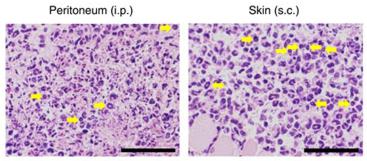Rat CD68 Recombinant
Categories: Surface & Soluble ReceptorsRecombinant Human Cytokines$160.00 – $1,950.00
Description
Accession
Q4FZY1
Source
Optimized DNA sequence encoding extracellular domain of Rat CD68 (macrosialin) including a C terminal His tag was expressed in HEK293 cells.
Molecular weight
Recombinant Rat CD68 (macrosialin)is a monomer protein consisting of 290 amino acid residue subunits, due to glycosylation migrates as an approximately 70kDa protein on SDS-PAGE.
Purity
>98%, as determined by SDS-PAGE and HPLC
Endotoxin
Endotoxin content was assayed using a LAL gel clot method. Endotoxin level was found to be less than 0.1 ng/µg(1EU/µg).
Presentation
RecombinantRat CD68 (macrosialin)is supplied as lyophilized 0.2 μm filtered PBS solution, pH7.2 .
Storage
RecombinantRat CD68 (macrosialin), as supplied, can be stored in working aliquots at 2° - 8° C for one month, or at -20°C to-70°Cfor twelve months. Avoid repeated freeze/thaw cycles.
Usage
This product is for research purposes only.It may not be used for therapeutics or diagnostic purposes.
Methods
Cells and antibodies
- Human monocytes were obtained from leukocyte-enriched buffy coats obtained from healthy volunteer blood donors drawn at the of in accordance with the written approval of the Director of the and the and Ethics Committee of the University of, Medical and Health Science .
- Written informed consent was obtained from the donors prior to blood donation, and their data were processed and stored according to the principles expressed in the Declaration of Helsinki.
- Human monocytes were isolated as described previously
γIMCs are the source of IFN-γ in severe invasive GAS infections.
- (f) Sorted IMCs were cultured with control medium (Med), G-CSF (50 ng ml−1), M-CSF (10 ng ml−1), GM-CSF (10 ng ml−1), or IL-5 (10 ng ml−1) for 2–4 days, and their absolute numbers were counted on the indicated days.
In vitro Osteoclast Formation Induced by Plasma from Treated Rats
-
To determine whether circulating factors may play a role in osteoclastogenesis after long-term MTX treatments,
in vitro osteoclast formation assay was performed to examine whether plasma derived from treated rats could induce osteoclast formation from bone marrow cells of normal rats. - Briefly, non-adherent hematopoietic cells isolated from normal rats were plated in 96-well trays at the density of 3×105 cells/well in triplicate, and cultured overnight in α-MEM media containing 50 µg/ml Pen/Strep, 15 mM HEPES, 10 ng/ml macrophage-colony stimulating factor (M-CSF) , and 10% plasma from control rats or treated rats.
- Cells were then fed the next day with similar plasma-containing media excluding M-CSF and any other exogenous osteoclastogenic factors except RANKL for the positive control (M-CSF+RANKL).
- To determine whether IL-1β plays a role in plasma-induced osteoclast formation, a neutralizing antibody against IL-1β at two different concentrations (0.04 and 0.08 ng/ml) was added to the plasma-containing media as described +…
Materials
- at CCL5, CCL7, CCL20 were from& and CXCL2 from.


